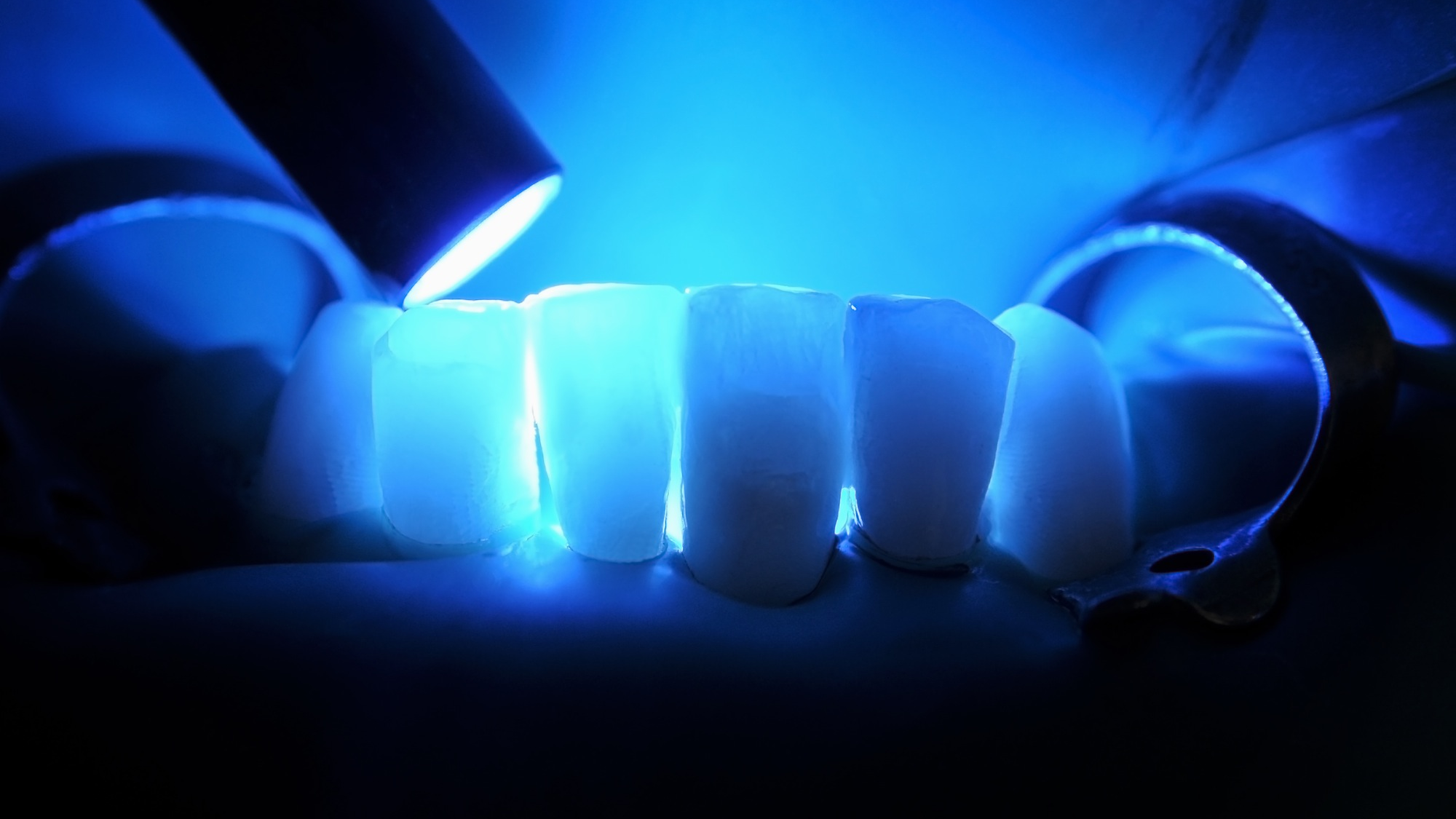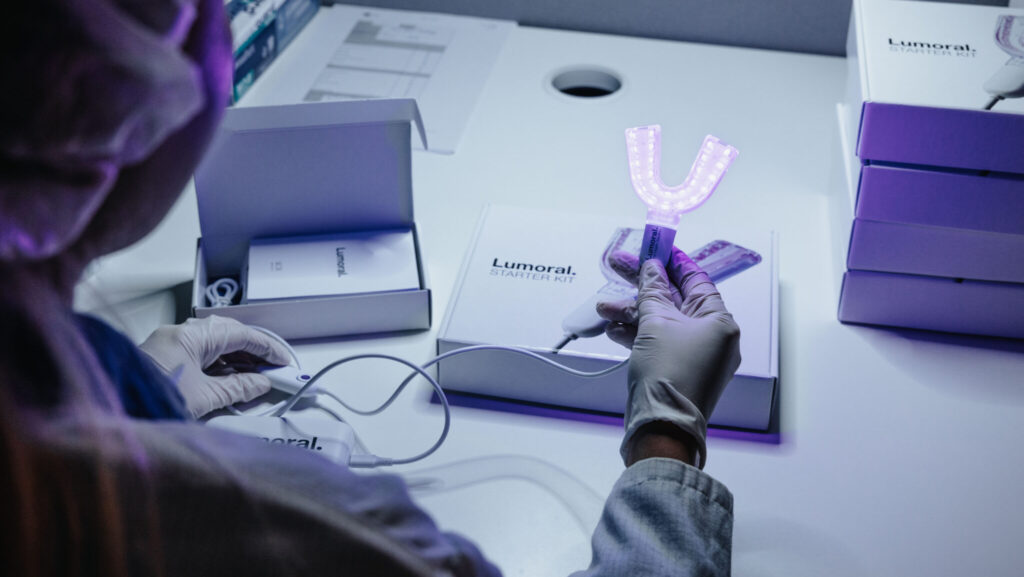
Finnish scientists have introduced an innovative oral hygiene solution, Lumoral (Koite Health Ltd., Espoo, Finland), the first antibacterial photodynamic device designed for home use. Lumoral harnesses light energy to combat oral diseases and complements existing cleaning methods to enhance home oral care. By selectively eliminating harmful bacteria in dental plaque, Lumoral represents a revolutionary advancement poised to transform oral health.
Lumoral’s patented dual-light technology uniquely combines endogenous and exogenous antimicrobial effects to target pathogenic plaque bacteria.1 The exogenous action is delivered by 810nm antibacterial photodynamic therapy (aPDT) using an indocyanine green (ICG) mouth rinse, paired with 405nm antibacterial blue light (aBL).2,3 This dual mechanism provides potent antibacterial effects without contributing to antimicrobial resistance, setting Lumoral apart from conventional treatments.
The antibacterial blue light (aBL) stimulates chromophores in bacterial cells, leading to the production of reactive oxygen species (ROS). These reactive molecules damage bacterial cell membranes and proteins, ultimately killing the bacteria. Additionally, aBL enhances cellular energy production in mitochondria through photo-biomodulation effects.2,3
Meanwhile, aPDT leverages ICG molecules, delivered via the Lumorinse mouth rinse. After binding selectively to dental biofilm, these molecules, when activated by 810nm light, generate localized heat and singlet oxygen, effectively eliminating bacteria, viruses, and fungi without adverse side effects. In addition, the 810nm light enhances cellular energy production in mitochondria through photo-biomodulation effects.2,3 (Fig. 1)
Fig. 1
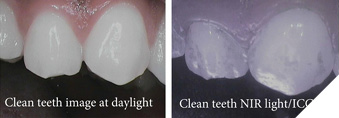
A game-changer in biofilm management
Controlling oral biofilm, or plaque, is vital in preventing oral diseases such as gingivitis, periodontitis, and caries. Studies show that some 95% of all oral health problems originate from the harmful effects of dental plaque surrounding teeth surfaces and the gum line. This biofilm, if not removed regularly, is where tartar originates.
Mechanical oral hygiene, regular brushing and interdental flossing, is the key to a healthy mouth. Unfortunately, research reveals that even the most efficient electric toothbrush removes only 60% of dental plaque.4 The remaining sticky substance chronically surrounding tooth surfaces and gum lines, often invisible to the eye, is the culprit behind the growing burden of oral diseases, extending to systemic health concerns such as cardiovascular diseases and diabetes.
Lumoral is an advanced health technology product with a medical device status for treating and preventing oral diseases at home, recommended by the Finnish Association of Dental Hygienists and used by many dentists throughout Europe and Asia. It eliminates biofilm bacteria and disrupts biofilm structures, leading to significantly improved regular oral hygiene, reducing the risk of periodontal disease and tooth decay.1,5
It is important to note that Lumoral does not replace traditional brushing or flossing; Lumoral does, however, provide a highly effective adjunct therapy that helps patients regain control over their biofilm. Many patients struggle to maintain a healthy oral microbiome, and Lumoral’s plaque-targeted action elevates their homecare to a higher level (Fig. 2).
Fig. 2
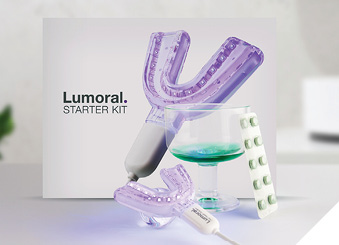
Lumoral vs. traditional antibacterial treatments
Unlike traditional antibacterial treatments such as chlorhexidine, Lumoral does not rely on chemical agents that may create unwanted side effects. Pharmaceutical antibacterial agents can be effective but are unsuitable for long-term use due to these side effects. Lumoral, on the other hand, provides a safe and efficient alternative without these chemical drawbacks. What sets Lumoral apart is its ability to target harmful bacteria while preserving the beneficial flora of the mouth—something conventional treatments often fail to achieve (Fig 3).
Fig. 3
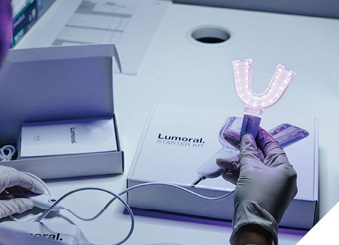
Antibacterial photodynamic therapy has long been studied and applied in professional dentistry, but Lumoral now makes this advanced technology accessible for home care. More than 15 clinical studies show excellent results.
In a randomized controlled trial at the University of Helsinki involving 200 periodontitis patients (HOPE-CP), those using Lumoral showed significantly better outcomes in:
- Improved oral hygiene
- Reduced gum inflammation
- Reduction in deep periodontal pockets
A recent multicenter study under peer review showed similar benefits of adjunct Lumoral use. Further research is ongoing in areas like orthodontics, mucositis, and peri-implantitis, consistently supporting Lumoral’s effectiveness.
Impact on systemic health
Current research increasingly supports the link between oral and systemic health, particularly in conditions such as diabetes, cardiovascular disease, Alzheimer’s, and preterm birth. By making biofilm control feasible for many patients, and preventing oral inflammation, systemic health can be significantly influenced. Germany, where aPDT was first developed, has been a leader in the adoption of the technology. Most German dentists are familiar with aPDT and understand its benefits. A group of high-level experts, led by Professor Dirk Ziebolz, has already recognized Lumoral’s potential to transform oral care, and in Germany, the profession is working on tailored dental insurance policies that will include Lumoral. Additionally, dental hygiene schools in Germany are incorporating Lumoral into their training, requiring students to document case reports. Educators report that they have never seen such impressive improvements in such a short time in over 35 years of experience.
While Lumoral benefits anyone looking to improve oral hygiene, certain patient groups stand to gain the most from its use:
- Diabetics – maintaining good oral health is crucial, as gum inflammation can negatively impact blood sugar control. Lumoral can contribute to better glycaemic management and overall health by reducing inflammation.
- Patients with dental implants – face the risks of peri-implantitis, a condition that can lead to implant failure. Lumoral helps prevent bacterial infections around implants, supporting their long-term success and stability.
- Periodontitis patients – traditional treatments alone may not always be enough to control the disease. Lumoral amplifies periodontal therapy by reducing harmful bacteria and inflammation, improving treatment outcomes, and a healthier mouth.
- Pregnancy – hormonal changes can increase the risks of gum disease and oral infections. Certain antibiotics are contraindicated during pregnancy. Lumoral provides a safe and effective alternative for managing oral health without medication-related risks.
- Not-at-risk dental patients – every patient can benefit from Lumoral use several times per week to maintain oral health. It keeps the mouth feeling fresh and clean, just like a visit to the dental hygienist.
Can Lumoral reduce antibiotic use in dentistry?
There are growing concerns over antibiotic resistance. The World Health Organization (WHO) has identified antibiotic resistance as the world’s most pressing global threat, and thus, alternative antimicrobial strategies are in great demand. Antibiotics may have reached their peak in periodontal treatment. Side effects no longer justify their widespread use.
The day is rapidly dawning when dentistry will no longer use antibiotics to treat periodontitis. Lumoral has the potential to be a viable alternative protocol without side effects.
Lumoral should be considered as an essential safeguard for dental treatments, protecting treatments such as direct restorations, crowns, implants, and orthodontics. By encouraging patients to use Lumoral at home as an adjunct therapy to mechanical oral hygiene, dentists and hygienists can help to maintain oral health, enhance the longevity of their work, and improve overall treatment outcomes.
Major clinical trial confirms Lumoral’s efficacy in advancing periodontal health outcomes
Preliminary findings from the HOPE-CP clinical trial were presented at the EuroPerio 11 Congress in Vienna, Austria, in May 2025. The trial evaluated the adjunctive use of Lumoral, an advanced antibacterial light-activated treatment, in combination with non-surgical periodontal therapy (NSPT).
In this randomized study, participants received either standard NSPT alone or NSPT combined with Lumoral use. Early analyses suggest that adjunctive Lumoral use may support improved periodontal health outcomes, including better plaque
control and reduced signs of gum inflam-mation compared to standard care alone.
The HOPE-CP investigation forms part of Senior Lecturer Saila Pakarinen’s PhD research at Metropolia University of Applied Sciences. “We are encouraged by the early findings, which indicate that Lumoral has the potential to enhance the management of periodontitis when used in conjunction with existing treatment protocols,” Pakarinen comments.
Final clinical results will be submitted for publication in a peer-reviewed journal. The interim results of the study have been published earlier.6 Ongoing research continues to explore the broader applications of Lumoral technology across various fields of oral healthcare.
Oral Health welcomes this original article.
References
- Pakarinen S, Saarela RKT, Välimaa H, et al. Home-applied dual-light photodynamic therapy in the treatment of stable chronic periodontitis (HOPE-CP)—three-month interim results. Dent J (Basel). 2022;10(11):206. doi:10.3390/dj10110206
- Nikinmaa S, Alapulli H, Auvinen P, et al. Dual-light photodynamic therapy administered daily provides a sustained antibacterial effect on biofilm and prevents Streptococcus mutans PLoS One. 2020;15(5):e0232775. doi:10.1371/journal.pone.0232775
- Nikinmaa S, Moilanen N, Sorsa T, et al. Indocyanine green-assisted and LED-light-activated antibacterial photodynamic therapy reduces dental plaque. Dent J (Basel). 2021;9(5):52. doi:10.3390/dj9050052
- Aggarwal N, Gupta S, Grover R, Sadana G, Bansal K. Plaque removal efficacy of different toothbrushes: a comparative study. Int J Clin Pediatr Dent. 2019;12(5):385-390. doi:10.5005/jp-journals-10005-1669
- The Finnish Oral Hygiene Association recommends Lumoral. Finnish Association of Dental Hygienists. September 1, 2022. https://www.suuhygienistiliitto.fi/suomen-suuhygienistiliitto-suosittelee-lumoralia/
- Unpublished data. Interim results: Pakarinen S, Saarela RKT, Välimaa H, et al. Home-applied dual-light photodynamic therapy in the treatment of stable chronic periodontitis (HOPE-CP)—three-month interim results. Dent J (Basel). 2022;10(11):206. doi:10.3390/dj10110206
About the authors

Professor Werner Birglechner, Head of the PraxisDienste Institute and Private University Medical School 11, Heidelberg, Germany, plays a key role in dental education, training approximately one-third of Germany’s new prophylaxis assistants and 50% of the country’s dental hygienists.

Dr. Tommi Pätilä, Paediatric Cardiac Surgeon (HUS New Children’s Hospital, Finland), identified oral bacteria as the cause of a severe heart condition in a young child in 2016. This discovery led him to seek more effective plaque removal methods and collaborate in the scientific development of Lumoral.

Nina Garlo-Melkas, MSc (Economics), is an experienced journalist specialising in finance, health, and science, making complex medical and scientific topics understandable to the general public. Currently working in communications, she is advancing health awareness by delivering valuable insights into healthcare and science.

